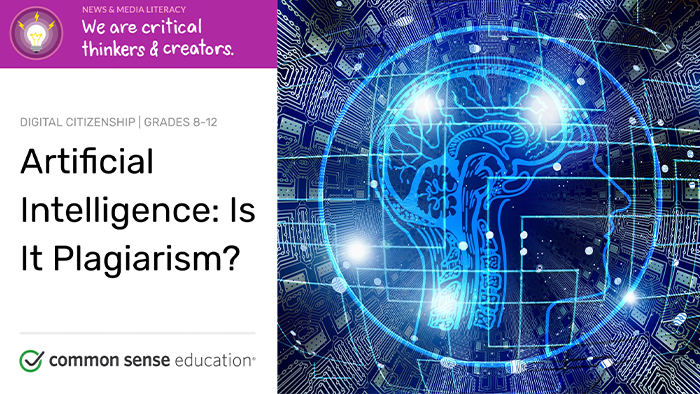Here's what educators can do as this technology evolves.

Have you ever heard anyone joke about robots taking over the world? Those quips were based on a reality that felt impossibly far ahead, but now there's a certain anxiety behind them. Artificial intelligence, or AI, is very real and pretty powerful. And while tools like ChatGPT have captured headlines, we interact with AI every day we're online.
So what is it, exactly? It comes in several forms, from simple automation to social intelligence. Algorithms control what ads we see online, the movement of self-driving cars, and those bots that pop up to answer questions when we're shopping online. Apps like Lensa use AI with images, and some programs generate images that are truly eerie—or utterly unethical. Google has an AI music generator. And while no AI has achieved true, Westworld-style self-awareness yet, there are plenty of examples of "companion" AI programs meant to stand in as friends. There are even AI-generated personas and social media stars!
We also see AI at work in schools. Some edtech uses adaptive learning, which is a form of AI, and facial recognition also qualifies. But generative AI—like writing tools that can create whole essays based on a simple prompt (like ChatGPT and Bard)—is a relatively new frontier, especially in classrooms. While predictive text is something we encounter in Google Docs or text messaging, it's pretty novel to have a program deliver an entire piece of writing based on simple questions or requests. And while its ability to create truly original content isn't there yet, it's still a concern for many educators.
Current Concerns
As technology evolves and becomes more sophisticated, it's understandable that we're uneasy about actual and anticipated challenges. Here are some current concerns:
- Plagiarism
- One of the biggest worries for teachers is plagiarism. Already, students are handing in AI-generated essays as their own.
- Ethics
- Because AI tools scrape content from a wide variety of sources, the material produced is a mixture of many other people's work, and there's no credit for creators.
- Biases and misinformation
- AI can only learn from its source(s), so it takes on the biases, misinformation, and problematic content of the original material. And if the team of developers isn't representative, it's almost guaranteed that implicit bias will be woven into the framework of the tool, as facial recognition has illustrated.
What It Means for the Future
Because the development of technology won't slow down enough for us to truly think about—and plan for—its implications, we can explore this uncertainty with students.
- Smarter and faster
- Over time, AI is only going to get more powerful and further woven into everyday life, probably in more ways than we can currently expect, both positive and negative.
- New access issues
- In terms of school, more AI won't necessarily come along with more access to it. We're already grappling with a digital divide, and ChatGPT already has a paid version. That means any advantage that some kids get will give them yet another edge over kids whose families can't afford it.
- Increased privacy issues
- We also don't know all of the impacts that AI will have on privacy. If we've learned one thing, it's that data is a hot commodity. So if AI can gather even more intel on us, it definitely will.
- Changes to job markets and skills
- Finally, we can only guess at all of the ways AI will change the job market. Preparing students for a world we can't quite even imagine is a true challenge.

How to Handle Concerns
With all of these worries and uncertainties, it's no wonder that some educators are overwhelmed by the whole idea. But try not to panic! There are things we can do and resources we can use.
How to Handle Plagiarism
- Play with AI platforms yourself to understand what they can and can't do. Plug in your prompts and test them.
- Get to know students' writing as much as possible.
- Do some writing in class, staying mindful of some students' limitations to do so.
- Use formative assessment to get snapshots of progress over time.
- Evaluate your prompts and try to include a student-centered approach that features emotional intelligence and experience. As one teacher says, "If you don't want generic answers, don't ask generic questions."
- Test AI tools together and discuss their limitations.
- As a last resort, there are tools you can use to detect AI, but be aware that they aren't perfect and flag plagiarism where it doesn't exist almost half of the time.
Programs like ChatGPT lack the ability to form emotional connections with readers. We cannot rob writing of human emotion. — Rose, 18
How to Handle the Ethics Involved
- Talk about the sketchy ethics of how generative AI works, but also get into a larger discussion about the impacts of technological developments and how we could/should be handling them.
- Talk about the existing digital divide and what new developments will mean for people who can't afford them. What happens as tools like this start to cost money for more features?
- Use facial recognition as an example, since we know it already exhibits bias. What will it take to minimize that bias? How can we prevent AI from perpetuating existing problems?
- Discuss the protection of intellectual property. What guardrails do we need if we want to get ahead of potential problems?
- Talk about data privacy. What information does AI currently collect, and what might it gather in the future?
A focus on transparency is needed as more and more corporations start including AI in their products. — Andrea, 17
How to Handle Considerations for the Future
- Be futurists: Ask students what they think AI is doing to reshape the job market and what skills they think they'll need.
- Create a project-based assignment that lets students do some research around this tech that will surely shape their lives.
- Talk about what regulations should apply to AI and what policies the government should develop.
As technology rapidly improves, we learn to embrace it and ChatGPT should be no exception. — Audrey, 17
Other Ways to Use It
On the flip side of all of these concerns, however, is the utility: What if you could just ask an AI program to write a lesson plan, a letter home, an email? Play around with it and figure out how AI might serve you. It is a tool, after all! What if AI could give you some of what so many teachers deeply need but never have enough of (other than money)—TIME?!?!
- Make it work for you! Take a look at this post from Ditch That Textbook to get some great ideas for use.
- Have students use coding to write their own algorithms.
- Have students write to a prompt and compare their results with those of an AI program. Dig into the differences.
- Use AI to generate art, noting the origins of its materials.
- Get into the math behind algorithms and machine learning.
- Discuss the many uses AI has in science: How can something like an algorithm or generative AI help move scientific research forward?
- Talk about the impacts of new technologies—including AI—on civilizations and societies in history and today.
I typically talk about what the most common college application essay topics are, but this year I made ChatGPT write those essays! We'll talk about what the AI did well and didn't do well and ways they could use it to help them with their college application process: Make a list of the application deadlines and required essays or a schedule of when all the application materials are due. — Patricia Monticello Kievlan, Educator
More Tools and Resources
Lessons and Tips
- Artificial Intelligence: Is It Plagiarism?
- AI Explained (video)
- What are AI Chatbots? (video)
- Curated Lives
- Are Deepfake Videos a Threat to Democracy?
- Do Algorithms Influence Our Lives and Our Democracy?
- EdWeb: Transforming Education with AI: What Educators Need to Know
- Guide to ChatGPT for Parents and Caregivers
- Teaching With AI: A Educators' Guide from Open AI
Tools and Resources







